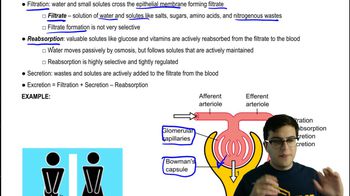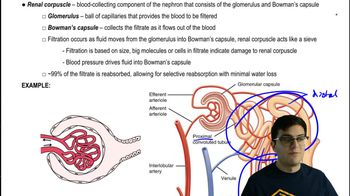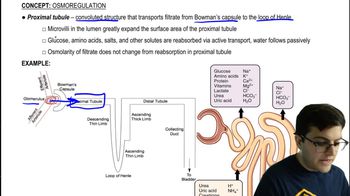Table of contents
- 1. Introduction to Biology2h 40m
- 2. Chemistry3h 40m
- 3. Water1h 26m
- 4. Biomolecules2h 23m
- 5. Cell Components2h 26m
- 6. The Membrane2h 31m
- 7. Energy and Metabolism2h 0m
- 8. Respiration2h 40m
- 9. Photosynthesis2h 49m
- 10. Cell Signaling59m
- 11. Cell Division2h 47m
- 12. Meiosis2h 0m
- 13. Mendelian Genetics4h 41m
- Introduction to Mendel's Experiments7m
- Genotype vs. Phenotype17m
- Punnett Squares13m
- Mendel's Experiments26m
- Mendel's Laws18m
- Monohybrid Crosses16m
- Test Crosses14m
- Dihybrid Crosses20m
- Punnett Square Probability26m
- Incomplete Dominance vs. Codominance20m
- Epistasis7m
- Non-Mendelian Genetics12m
- Pedigrees6m
- Autosomal Inheritance21m
- Sex-Linked Inheritance43m
- X-Inactivation9m
- 14. DNA Synthesis2h 27m
- 15. Gene Expression3h 20m
- 16. Regulation of Expression3h 31m
- Introduction to Regulation of Gene Expression13m
- Prokaryotic Gene Regulation via Operons27m
- The Lac Operon21m
- Glucose's Impact on Lac Operon25m
- The Trp Operon20m
- Review of the Lac Operon & Trp Operon11m
- Introduction to Eukaryotic Gene Regulation9m
- Eukaryotic Chromatin Modifications16m
- Eukaryotic Transcriptional Control22m
- Eukaryotic Post-Transcriptional Regulation28m
- Eukaryotic Post-Translational Regulation13m
- 17. Viruses37m
- 18. Biotechnology2h 58m
- 19. Genomics17m
- 20. Development1h 5m
- 21. Evolution3h 1m
- 22. Evolution of Populations3h 52m
- 23. Speciation1h 37m
- 24. History of Life on Earth2h 6m
- 25. Phylogeny2h 31m
- 26. Prokaryotes4h 59m
- 27. Protists1h 12m
- 28. Plants1h 22m
- 29. Fungi36m
- 30. Overview of Animals34m
- 31. Invertebrates1h 2m
- 32. Vertebrates50m
- 33. Plant Anatomy1h 3m
- 34. Vascular Plant Transport2m
- 35. Soil37m
- 36. Plant Reproduction47m
- 37. Plant Sensation and Response1h 9m
- 38. Animal Form and Function1h 19m
- 39. Digestive System10m
- 40. Circulatory System1h 57m
- 41. Immune System1h 12m
- 42. Osmoregulation and Excretion50m
- 43. Endocrine System4m
- 44. Animal Reproduction2m
- 45. Nervous System55m
- 46. Sensory Systems46m
- 47. Muscle Systems23m
- 48. Ecology3h 11m
- Introduction to Ecology20m
- Biogeography14m
- Earth's Climate Patterns50m
- Introduction to Terrestrial Biomes10m
- Terrestrial Biomes: Near Equator13m
- Terrestrial Biomes: Temperate Regions10m
- Terrestrial Biomes: Northern Regions15m
- Introduction to Aquatic Biomes27m
- Freshwater Aquatic Biomes14m
- Marine Aquatic Biomes13m
- 49. Animal Behavior28m
- 50. Population Ecology3h 41m
- Introduction to Population Ecology28m
- Population Sampling Methods23m
- Life History12m
- Population Demography17m
- Factors Limiting Population Growth14m
- Introduction to Population Growth Models22m
- Linear Population Growth6m
- Exponential Population Growth29m
- Logistic Population Growth32m
- r/K Selection10m
- The Human Population22m
- 51. Community Ecology2h 46m
- Introduction to Community Ecology2m
- Introduction to Community Interactions9m
- Community Interactions: Competition (-/-)38m
- Community Interactions: Exploitation (+/-)23m
- Community Interactions: Mutualism (+/+) & Commensalism (+/0)9m
- Community Structure35m
- Community Dynamics26m
- Geographic Impact on Communities21m
- 52. Ecosystems2h 36m
- 53. Conservation Biology24m
42. Osmoregulation and Excretion
Osmoregulation and Excretion
Problem 8b
Textbook Question
Textbook QuestionScientists have noted that marine invertebrates tend to be osmoconformers, while freshwater invertebrates tend to be osmoregulators. Suggest an explanation for this phenomenon.
 Verified step by step guidance
Verified step by step guidance1
Step 1: Understand the terms. Osmoconformers are organisms that maintain their body fluids in osmotic balance with their environment, while osmoregulators actively regulate the osmotic pressure of their body fluids, maintaining them at a level different from that of their environment.
Step 2: Consider the environment. Marine environments have a high salt concentration, while freshwater environments have a low salt concentration. This difference in salt concentration is a key factor in determining whether an organism is an osmoconformer or an osmoregulator.
Step 3: Apply the concept to marine invertebrates. In the ocean, the high salt concentration means that the osmotic pressure of the water is similar to that of the invertebrates' body fluids. Therefore, marine invertebrates can be osmoconformers, as they do not need to expend energy to regulate their internal osmotic pressure.
Step 4: Apply the concept to freshwater invertebrates. In freshwater, the low salt concentration means that the osmotic pressure of the water is much lower than that of the invertebrates' body fluids. Therefore, freshwater invertebrates must be osmoregulators, actively expending energy to prevent water from flooding into their bodies and diluting their body fluids.
Step 5: Summarize the explanation. Marine invertebrates are osmoconformers because the high salt concentration in the ocean allows them to maintain osmotic balance with their environment without expending energy. Freshwater invertebrates are osmoregulators because they need to actively regulate their internal osmotic pressure to prevent their body fluids from being diluted by the low-salt freshwater environment.
Recommended similar problem, with video answer:
 Verified Solution
Verified SolutionThis video solution was recommended by our tutors as helpful for the problem above
Video duration:
1mPlay a video:
Was this helpful?
Key Concepts
Here are the essential concepts you must grasp in order to answer the question correctly.
Osmoconformers
Osmoconformers are organisms that maintain an internal environment that is isotonic to their external surroundings. This means that their body fluids have a similar concentration of solutes as the surrounding water, allowing them to avoid the energetic costs associated with actively regulating their internal osmotic pressure. Marine invertebrates, such as jellyfish and sea stars, often adopt this strategy due to the stable salinity of ocean water.
Recommended video:
Guided course

Osmosis and Osmolarity
Osmoregulators
Osmoregulators are organisms that actively control their internal osmotic pressure, allowing them to maintain a stable internal environment despite fluctuations in external conditions. Freshwater invertebrates, like certain species of worms and crustaceans, often face challenges from their dilute surroundings, necessitating mechanisms to excrete excess water and retain essential solutes. This active regulation is crucial for their survival in environments where water influx is a constant threat.
Recommended video:
Guided course

Osmoregulation and Nitrogenous Waste
Environmental Adaptation
Environmental adaptation refers to the evolutionary processes that enable organisms to adjust to their habitats. The differences in osmotic strategies between marine and freshwater invertebrates illustrate how species have evolved specific physiological traits to thrive in their respective environments. These adaptations are essential for survival, influencing not only water balance but also overall metabolic functions and ecological interactions.
Recommended video:

Adaptive Radiation

 7:16m
7:16mWatch next
Master Osmoregulation and Nitrogenous Waste with a bite sized video explanation from Jason Amores Sumpter
Start learningRelated Videos
Related Practice

































































